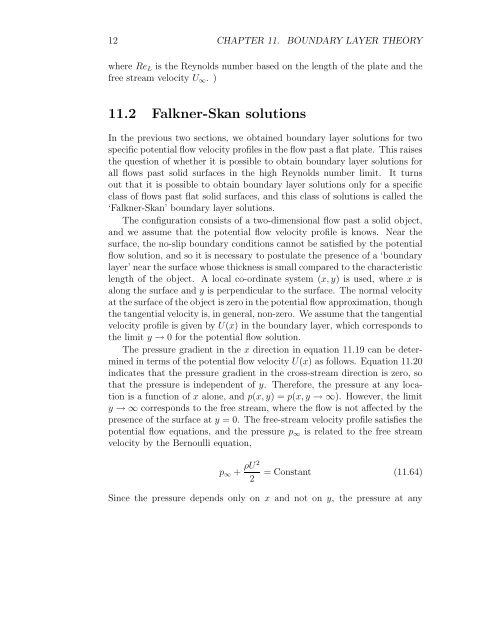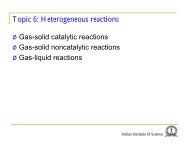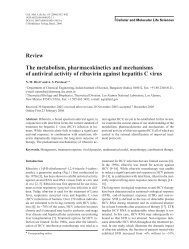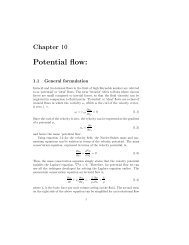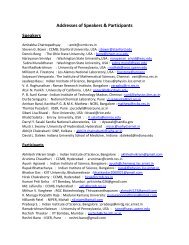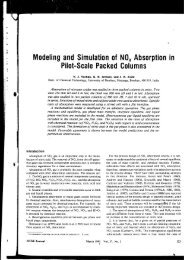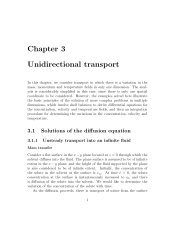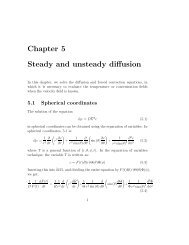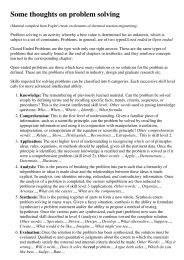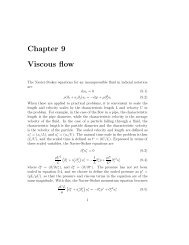Chapter 11 Boundary layer theory
Chapter 11 Boundary layer theory
Chapter 11 Boundary layer theory
Create successful ePaper yourself
Turn your PDF publications into a flip-book with our unique Google optimized e-Paper software.
12 CHAPTER <strong>11</strong>. BOUNDARY LAYER THEORY<br />
where Re L is the Reynolds number based on the length of the plate and the<br />
free stream velocity U ∞ . )<br />
<strong>11</strong>.2 Falkner-Skan solutions<br />
In the previous two sections, we obtained boundary <strong>layer</strong> solutions for two<br />
specific potential flow velocity profiles in the flow past a flat plate. This raises<br />
the question of whether it is possible to obtain boundary <strong>layer</strong> solutions for<br />
all flows past solid surfaces in the high Reynolds number limit. It turns<br />
out that it is possible to obtain boundary <strong>layer</strong> solutions only for a specific<br />
class of flows past flat solid surfaces, and this class of solutions is called the<br />
‘Falkner-Skan’ boundary <strong>layer</strong> solutions.<br />
The configuration consists of a two-dimensional flow past a solid object,<br />
and we assume that the potential flow velocity profile is knows. Near the<br />
surface, the no-slip boundary conditions cannot be satisfied by the potential<br />
flow solution, and so it is necessary to postulate the presence of a ‘boundary<br />
<strong>layer</strong>’ near the surface whose thickness is small compared to the characteristic<br />
length of the object. A local co-ordinate system (x, y) is used, where x is<br />
along the surface and y is perpendicular to the surface. The normal velocity<br />
at the surface of the object is zero in the potential flow approximation, though<br />
the tangential velocity is, in general, non-zero. We assume that the tangential<br />
velocity profile is given by U(x) in the boundary <strong>layer</strong>, which corresponds to<br />
the limit y → 0 for the potential flow solution.<br />
The pressure gradient in the x direction in equation <strong>11</strong>.19 can be determined<br />
in terms of the potential flow velocity U(x) as follows. Equation <strong>11</strong>.20<br />
indicates that the pressure gradient in the cross-stream direction is zero, so<br />
that the pressure is independent of y. Therefore, the pressure at any location<br />
is a function of x alone, and p(x, y) = p(x, y → ∞). However, the limit<br />
y → ∞ corresponds to the free stream, where the flow is not affected by the<br />
presence of the surface at y = 0. The free-stream velocity profile satisfies the<br />
potential flow equations, and the pressure p ∞ is related to the free stream<br />
velocity by the Bernoulli equation,<br />
p ∞ + ρU2<br />
2<br />
= Constant (<strong>11</strong>.64)<br />
Since the pressure depends only on x and not on y, the pressure at any


